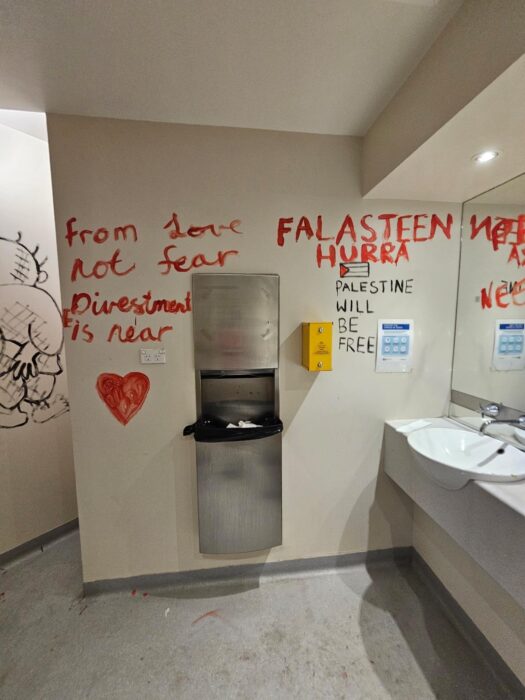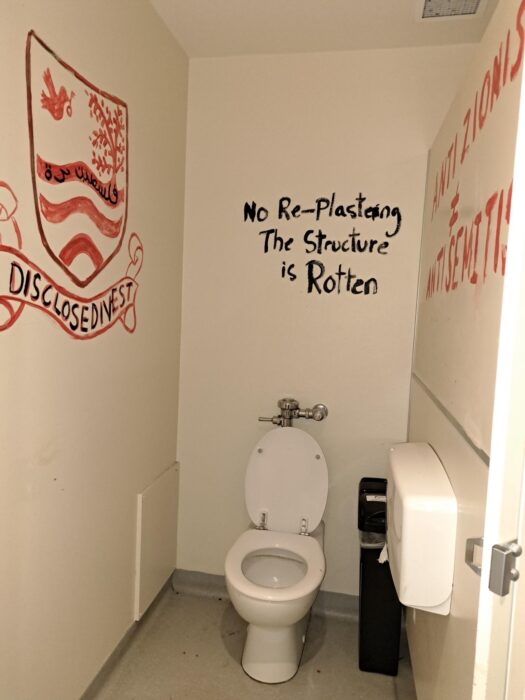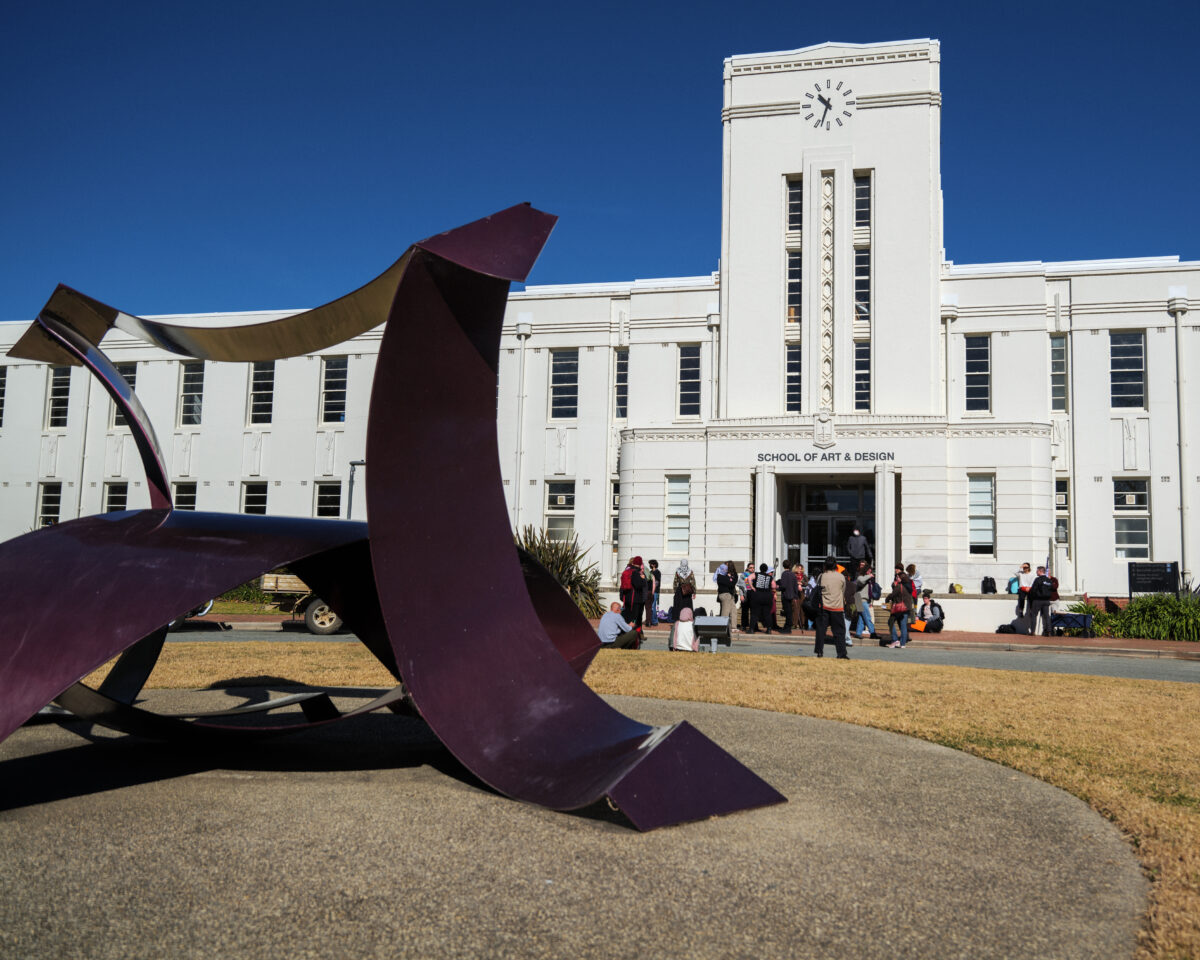During the 2024 Drawing Prize ceremony on the evening of 28 August, a group of ANU students began to lay down at the front of the ceremony, as Head of ANU School of Art and Design (SOAD) Mitchell Whitelaw announced the winners.
Five students quietly stood beside Whitelaw, holding signs which read, “SOAD is censoring student protests & blocking displays of the Palestinian flag in the Gallery”, and “We will disrupt business as usual while ANU supports Israeli Genocide.”
The ‘die-in’ demonstration came after students staged a sit-in and guerilla exhibition earlier in the month on 6 August, where protestors re-named the SOAD gallery to the Shabebeek Memorial Gallery.
Both protests call on the SOAD’s to set a date for another Pro-Palestine and anti-war exhibition following the theft and vandalism of multiple artworks during a June exhibition.
Shababeek Memorial Gallery: Art or Vandalism?
In a press release, protesters explained the guerilla sit-in on 6 August, “was in response to the University’s silencing of artistic expression and censorship of a pro-Palestine art exhibit and ongoing funding cuts to SOAD.”
They state, “An exhibition about student activism on campus, featuring pro-Palestine activist art was vandalised and artwork stolen in a racist attack on the 12th of June. ANU has not only failed to release any outcome of its investigation, but they also claimed that the space is not insured and therefore they cannot compensate the students for the stolen and vandalised artwork.”
“SOAD management offered students a new date for the exhibition in early August, then rescinded their offer. Organisers were informed behind closed doors that the Project Space would no longer be available for students and staff to exhibit, and the space would only be available for teachers to exhibit coursework. The ANU Project Space previously served as a ‘dynamic display [area], designed to support presentation of research, creative outcomes, collaborations and more.”
During the sit-in, students posted pro-Palestine artwork on the walls of the exhibit, and announced that the gallery would be re-named to the Shabeek gallery.
They explained, “Shababeek gallery is a contemporary arts centre in Gaza established in 2009. Shababeek means window.”
“This March Shababeek was destroyed in the siege near Al Shifa Hospital. Genocide encompasses destruction of people, including arts and culture. 20,000 artworks housed in the art centre have been destroyed.”
Protestors maintain, “In practising artistic expression in spite of the university’s racist censorship, the students demonstrated the ideals of academic freedom and community that a university should aspire for.”



ANU security were present, and monitored the protest and demonstrations. They did not intervene nor did they tell students to stop.
However, following the protest, all artwork was removed by University staff later in the day.
On the following day, in an email to all College of Arts and Social Sciences (CASS) students, CASS Dean Professor Bronwyn Parry, addressed the protest saying the protest, “resulted in significant damage to the building, disruption to operations, and considerable distress for a number of staff and students.”
“In addition to chanting and speeches, the protest saw slogans and other materials applied to the interior walls of the building, and extensive damage was caused to the female bathrooms.”
Woroni understands that during the protest, protestors had graffitied the walls of the female bathroom with markers. The ANU has yet to publicly announce the costs of repairing the “extensive damage.” However, almost all the graffiti was removed within the next day of the protest.


In the email, the Dean continued, “We are investigating this incident and will take action under our staff and student codes of conduct where appropriate.”
“We are seeking more information, and anyone who witnessed property being damaged, or observed any conduct that should be investigated in relation to yesterday’s protest activity, can email me confidentially.”
In a press release, protestors responded, “The Dean also claimed that “this was not an artistic exhibition, it was protest activity”. We urge the Dean to read more about the history and practice of political art and protest, because the ignorance and racism in framing this as a protest is astounding!”
They continued, “We also encourage the Dean to not omit the background and context of the protest, as someone who should be a champion of the arts and social sciences, we are sure that they would appreciate that student protests do not appear out of nothing, and it would be good to explain to staff and students and the wider ANU community what has happened exactly rather than spreading misinformation about what protesters have done.”
“The Dean’s carceral logic also threatened the students weaponising the Students Code of Conduct which has been consistently used by ANU management to silence student protests on campus.”
The protestors have additionally characterised the University’s removal of the Shabebeek Gallary artwork as, “racist censorship.”
A breach of the student code of conduct could result in the suspension, expulsion, liability to pay monetary compensation, or the denial of access to the University.
The ANU has not publicly announced whether any ANU students have been found to breach the code of conduct.
The choice is yours ANU: an exhibition or a protest
The ANU has yet to publicly acknowledge the die-in from 28 August. Protestors held signs which read, “We demand: freedom of speech amd political expression, provide a new exhibition date, restore access to gallery, cut all ties with weapons manufacturers, companies and institutions which support Isreal’s genocide in Gaza.”
Finalists in the drawing competition, including the winners of the Drawing Prize and the People’s Choice Award, placed plaques next to their artworks, that read “I stand with Palestine and student protest”
An ANU spokesperson told Woroni, “ANU is a place of respectful debate, with a long history of student political engagement. All students and staff at ANU are covered by the University’s policies of academic freedom and free speech, and are free to express themselves on any issue in line with Australian law.”
They maintain, “However, we do not condone any actions or speech that are discriminatory or violate Australian law or our code of conduct. Protests, when they occur, must be undertaken lawfully, and in ways that are not detrimental to the wellbeing of members of our university community.”
Woroni understands that no date for an exhibition has been set. Protesters claim, “SOAD rescinded the offer of a new exhibition date [following the first one in early June] and informed the students that exhibiting Palestinian flags at SOAD makes some staff and students feel ‘unsafe’.”
As of now, protestors demand the, “SOAD to honour their prior agreement and provide a new exhibition date.”
“We also demand that SOAD restore access to the Shababeek Memorial Gallery for all staff and students, and permit students to express themselves artistically and politically.”
The claims of protestors come in the context of other claims by University students that their institutions are censoring pro-Palestine content. The University of Sydney admitted in May of this year to removing pro-Palestine graffiti from the University’s famous Graffiti Tunnel.
For many students, the University’s reluctance to provide an exhibition date for pro-Palestine activism has sparked concerns about the freedom of speech and right to protest on campus.
During the sit-in protest, standing on the stairs of the SOAD, one student said, “The university doesn’t want Palestinian flags hanging in the gallery halls.”
“The art school quietly removing access to the project space for exhibitions is part of the global anti-humanities trend, as the spaces of culture creation and critical thinking are systematically reduced.”
“Art creates culture. Art expands the idea of what can become true. But we do not need this institution to make art. This is our school. We are this art school. We call on this University for the right to exhibit art and speak freely, but we don’t wait for its permission.”

We acknowledge the Ngunnawal and Ngambri people, who are the Traditional Custodians of the land on which Woroni, Woroni Radio and Woroni TV are created, edited, published, printed and distributed. We pay our respects to Elders past and present. We acknowledge that the name Woroni was taken from the Wadi Wadi Nation without permission, and we are striving to do better for future reconciliation.
